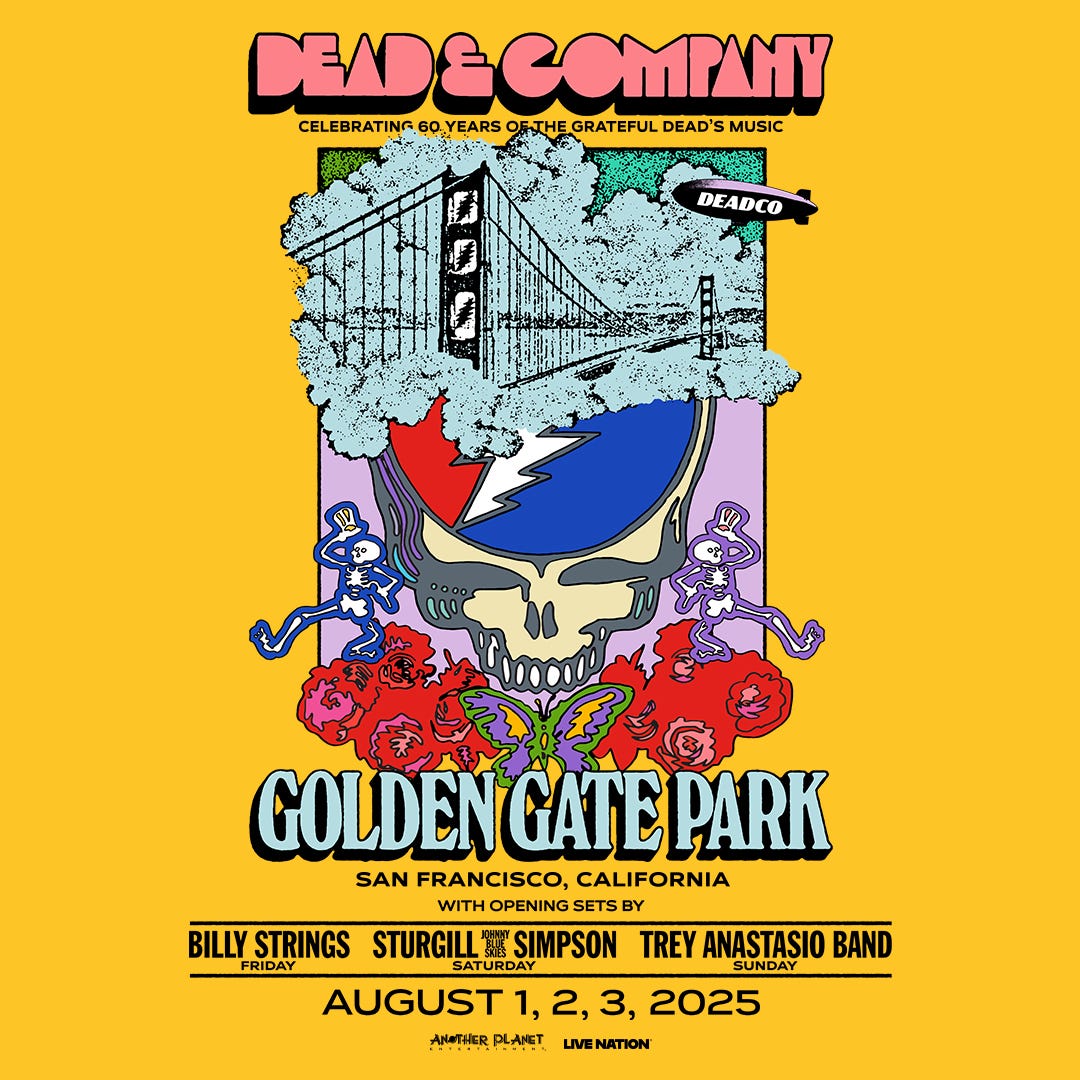Not many of us were paying attention, but May 5 was an auspicious day in some circles. Sixty years ago on Cinco de Mayo, a band called The Warlocks played at a joint called Magoo’s Pizza Parlor in Menlo Park, CA. Seven months later, The Warlocks were holed up in the Palo Alto bungalow of their bass player and searching for a new name (they’d discovered that several other bands were using the same moniker, including an early version of The Velvet Underground). The lead guitarist for the band, reportedly high on DMT, was flipping through a dictionary when the phrase “grateful dead” jumped out at him. The rest, as they say, is history.
For the next 30 years the Dead defined a genre, a lifestyle, and a city. Their run effectively ended in 1995 with the passing of Jerry Garcia, even though offshoots and tributaries continued over the years (Further was a personal favorite). About 10 years ago, surviving members formed Dead & Co. featuring John Mayer ably filling Jerry’s shoes. The band just ended an extended residency at Sphere in Las Vegas.
In 2024, about the time Dead & Co. were kicking things off in Vegas, Daniel Lurie was elected Mayor of San Francisco on a platform of reform and renewal. So far it seems to be working. On a recent visit to Baghdad by the Bay, the city did indeed appear calmer and cleaner. The Transamerica Pyramid, an iconic office building, has completed a $400 million renovation. People are slowly returning to work. AI startups are flourishing. Fentanyl zombies, once plentiful, are now a rare sight. And the city retains its natural beauty — as Frank Lloyd Wright once said, no matter what people do to San Francisco, it’s still beautiful.
Lurie has attacked San Francisco’s problems at the source. He’s gotten tough on crime, even for minor infractions, and beefed up police patrols in the city’s hot spots. He’s taken a pragmatic, coordinated approach to rehabilitation and homelessness, cut red tape for small businesses and recruited San Francisco’s business class to get actively involved in reviving the economy. He’s created optimism.
Then he did something really smart. He persuaded Dead & Co. to return to San Francisco and celebrate the Dead’s 60th anniversary. In Golden Gate Park. At the Polo Fields, about a mile-and-a-half from the band’s legendary house at 710 Ashbury Street. During the summer. It will be an event steeped in historical reference and the mystic cords of memory.
For better or worse, the so-called Summer of Love in 1967 put San Francisco on the map — following famous events and landmarks like the Beat movement, the Golden Gate Bridge and the Gold Rush. The Dead were progenitors of the conterculture. From their home base in the Haight, they radiated out through the city in those early years, playing the Carousel, the Fillmore, the Avalon, the Family Dog and other temples of hippie hedonism. They also famously played sporadic free concerts, from the Panhandle to Golden Gate Park.
The first time the Dead played the Polo Fields in Golden Gate Park was Jan. 14, 1967. The Human Be-In, as it was called, was a day-long “gathering of the tribes” — the hippies of San Francisco and the political radicals of Berkeley. The Dead were there, along with the Airplane, Quicksilver, Country Joe and the Fish, Dizzy Gillespie, Allen Ginsberg, Leary, Gary Snyder and a full roster of the emerging counterculture. It was the unlikeliest of events. The hippies, and their attendant street life, were giving San Francisco police a headache; the probability of getting a permit for a free concert in the park with a bunch of weed-smoking longhairs was near zero. One of the promoters, the intrepid artist Michael Bowen, found a workaround. He called his friend Melvin Belli, one of San Francisco’s most famous and flamboyant lawyers, and asked for help. Belli simply had his secretary call City Hall and get a permit for a birthday party in his honor in the park. It was issued on the spot. More than 20,000 people showed up and the Be-In became the template for the modern outdoor rock concert. The Monterey Pop Festival soon followed and decades later we have Coachella and the like.
Golden Gate Park has a long musical history, beginning with the Imperial Prater Vienna Symphony performing on the then-new Music Concourse at the 1894 Midwinter Exposition. Today it hosts established events such as Outside Lands and Hardly Strictly Bluegrass. After the Be-In, the Dead played a total of 14 times in the park, including a huge tribute to Bill Graham after his death in 1991. If anybody could be called the house band in Golden Gate Park, it would be the Dead.
Lurie gets it. If you’re trying to build a new future, one of the best ways to do it is to amplify the high points of history. Sixty years after cranking out “Cold Rain and Snow” and “Good Loving” at Magoo’s, the Dead will be rolling out “Althea,” “Shakedown Street,” and hopefully a vintage “Dark Star” in the park. It’s an homage not just to the Dead’s history, but the city’s too. San Francisco has always been different — the cool, gray city of love as Gary Kamiya called it. Even as Lurie tries to coax it into a new version of itself — tougher, more pragmatic, more functional — he’s honoring the past, in all its offbeat, transgressive glory. Can’t wait.






Love this!!!
Excellent column, Russ. The world needs contemporary historians like you, Russ.